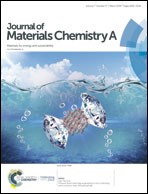Quest for 9-connected robust metal–organic framework platforms based on [M3(O/OH)(COO)6(pyridine)3] clusters as excellent gas separation and asymmetric supercapacitor materials†
Abstract
The controllable synthesis of highly stable porous metal–organic frameworks (MOFs) with targeted functions is urgently needed but still challenging up to now. In this work, we report the latest achievement in our continuous quest for robust 9-connected (9-c) MOFs based on [M3(O/OH)(COO)6(pyridine)3] building blocks. Different from the reported nets (ncb, xmz and pacs-MOFs) constructed from integrated or separated carboxylate and pyridine ligands, our metal–organic linker (MOL) strategy led to the discovery of six fascinating 9-c MOFs (SNNU-51–56) showing two types of completely new topological nets generated by cis, trans-coordination isomerism. As expected from highly connected architectures and the absence of open metal sites, all these MOFs show high thermal and moisture stability. They can even retain their frameworks after being treated at different pH values for 24 h. Furthermore, SNNU-51–56 not only inherit the excellent gas uptake performance of robust 9-c MOFs, but also exhibit extremely high CH4 separation from CO2, C2H2 and C2H4. Together with robust frameworks, the effective inner-cluster redox process in [M3(OH)(COO)6(pyridine)3] (M = Fe, Co and Ni) units makes SNNU-51–56 high-performance electrochemical pseudocapacitor materials. The asymmetric supercapacitor (ASC) fabricated with the SNNU-52 positive electrode and activated carbon (AC) negative electrode can be reversibly charged/discharged in a working voltage range of 0–1.6 V in 2 M KOH aqueous electrolyte for application in practical energy storage devices, and two serially connected ASCs can continuously light a light emitting diode. In all, greater control over the MOF structure, excellent thermal and chemical stability, and superb metal compatibility make [M3(O/OH)(COO)6(pyridine)3] clusters an ideal building block to design multifunctional MOF materials in the future.
![Graphical abstract: Quest for 9-connected robust metal–organic framework platforms based on [M3(O/OH)(COO)6(pyridine)3] clusters as excellent gas separation and asymmetric supercapacitor materials](/en/Image/Get?imageInfo.ImageType=GA&imageInfo.ImageIdentifier.ManuscriptID=C8TA09080G&imageInfo.ImageIdentifier.Year=2019)


 Please wait while we load your content...
Please wait while we load your content...